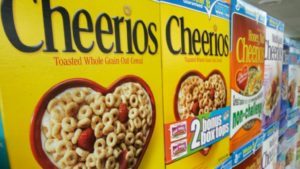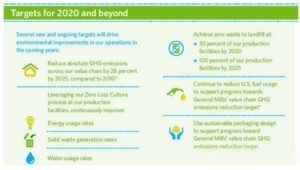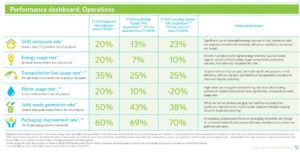The environmental impact behind a cereal box: How General Mills is addressing climate change
General Mills is the manufacturer of a wide portfolio of products, such as baking mixes, breakfast cereals, yogurt and ice-cream, and has very popular brands such as Cheerios, Yoplait and Haagen Dazs.
During the last few years, General Mills has been expressing its concern about sustainability and climate change, and in 2015, announced a formal commitment with quantitative targets and action plan.[1]
Why is General Mills concerned about climate change?
It may seem that General Mills’ business is not related or would not be affected by climate change. However, there are some important reasons that support why the company is addressing this problem.
First, many General Mill’s products depend on agriculture, using cocoa, corn and wheat as main raw materials. Climate change and the emission of GHG has negatively impacted the availability of these supplies, becoming a risk for business.[2]
Second, the use of clean energy can help reduce costs, thus improve products profitability. The company stated that they are using clean energy from oat hulls in their oat mill in Fridley “reducing the mill’s carbon footprint by 21 percent and saving more than $350 million in natural gas costs. In Guangzhou, China, General Mills reduced emissions by more than 25 percent after switching from oil to natural gas.” The company forecast that “this will save about $1 million yearly at the Guangzhou site alone.”[3]
Third, activists are generating a lot of pressure to big companies, demanding sustainable policies and tracing their implementation[4]. On one hand, sustainability and environmental concern can be part of a company’s strategy and can become a competitive advantage because generates goodwill in consumers. On the other hand, not being sustainable can lead to bad publicity and can destroy a company’s reputation.
A commitment with the future
In 2015 General Mills announced a series goals[5] to address climate change problems. It’s important to point out that the company’s efforts will impact the whole supply chain, from agriculture to the retails. In the corporate web page, the CEO of the company stated: “We know our greatest impact is outside our four walls – particularly in agriculture, ingredients and packaging. To reduce emission levels, we must work across our value chain with growers, suppliers, customers and industry partners. Together, we will identify new solutions and promote sustainable agriculture practices that drive emission reductions.”6
General Mills found that most of the GHG emissions and water consumption comes from its raw materials, particularly, from agriculture6.
For this reason, the company stated its commitment to sustainably source 100% of its 10 priority ingredients by 2020. These ingredients represent more than 50% of the annual raw material purchases. To accomplish the target, the company is building partnerships with suppliers to accelerate adoption of more sustainable agriculture practices that build climate-resilient, healthy soils.[6]
In addition, the company its changing its internal operations to reduce GHG emissions, energy consumption, transportation fuel, water consumption, and solid waste.[7]
Is that enough?
Even though General Mills’ policy regarding climate change is a great step to fight greenhouse emissions and climate change, there is still space to generate improvements, such as:
- Have stronger policies regarding other raw materials such as palm oil, as “when deforestation occur to make way for oil palm plantations, the sequestered carbon is released into the atmosphere as carbon dioxide, contributing to global warming.”[8]
- Establish guidelines and controls to guarantee the reduction of GHG emissions on agriculture. It’s not only important to build partnerships, but also to trace the source of raw materials and have the mechanisms to control and report the reduction of GHG emissions.
- Evaluate changes in the portfolio of products to decrease the diary consumption, because “a cow does on average release between 70 and 120 kg of Methane per year. Methane is a greenhouse gas like carbon dioxide (CO2). But the negative effect on the climate of methane is 23 times higher than the effect of CO2.”[9]
- Raise the environment concern in retailers and consumers, who are the last pieces in the supply chain. (784 words)
Endnotes
[1] General Mills. 2015. General Mills announces new commitment on climate change. [ONLINE] Available at: https://www.generalmills.com/en/News/NewsReleases/Library/2015/August/Climate-Commitment.
[2] The Huffington Post. 2015. General Mills Warns Climate Change Will Lead To Global Food Shortages. [ONLINE] Available at: http://www.huffingtonpost.com/entry/general-mills-warns-climate-change-will-lead-to-global-food-shortages_us_55e45e5ce4b0c818f6186305
[3] Environmental Leader. 2015. Why General Mills, Dell, Unilever care about the COP21 Climate Talks. [ONLINE] Available at: http://www.environmentalleader.com/2015/11/04/why-general-mills-dell-unilever-care-about-the-cop-21-climate-talks/#ixzz4P23Qx9yC.
[4] Los Angeles Times. 2014. General Mills drops GMOs from Cheerios. [ONLINE] Available at: http://www.latimes.com/business/la-fi-cheerios-gmo-20140104-story.html.
[5] https://www.bsr.org/our-insights/blog-view/how-general-mills-worked-with-bsr-to-set-climate-targets
[6] General Mills. 2015. General Mills announces new commitment on climate change. [ONLINE] Available at: https://www.generalmills.com/en/News/NewsReleases/Library/2015/August/Climate-Commitment.
[7] General Mills. 2015. Our approach. [ONLINE] Available at: https://www.generalmills.com/Responsibility/Environment/environment-approach.
[8] Union of Concerned Scientists. 2015. Palm Oil and Global Warming.
[9] Time for Change. 2008. Are cows the cause of global warming?. [ONLINE] Available at: http://timeforchange.org/are-cows-cause-of-global-warming-meat-methane-CO2.







Really interesting article! It was surprising to me to see that over one third of General Mill’s CO2 emissions came from agriculture and the transformation steps– if I had to guess, I would have guessed that a lot of it came from consumption (e.g., packaging that is then burned and potentially secretes byproducts that contribute to global warming). I noticed that shipping is the second largest source of CO2 emissions for General Mills. As next steps for the company, I would encourage them to also focus on reducing CO2 emissions during transportation, such as by moving production closer to the customer (onshore).
It’s very interesting to think about how sustainability affects such a large organization and the different areas of their value chain that can be used as levers to improve environmental friendliness. I am curious to know what angle you are taking in your suggestions to the business. Are these purely actions you think would help the environment? It seems like General Mills would be more likely to implement these if they either 1. produced costs savings for the business or 2. these measures in particular are likely to lead to strong backlash from interest groups. Do you think that either of these apply to any of your suggestions? Or do you think that consumers would positively react in their purchase behavior if GM implemented these measures? Or do consumers in this category look primarily at price?
Great connection from the sustainable supply chain all way to the consumer caring about environmentalism! It seems like a pretty lofty goal for General Mills to commit to 100% sustainable sources for their 10 priority ingredients. I wonder if they will be able to maintain a similar price of supply or even find enough sources that meet those criteria?
For such a large CPG company, it’s interesting to consider the many points on the supply chain that a sustainability initiative would effect. In particular, I am surprised to learn that General Mills has committed to sustainably source 100% of its top priority ingredients by 2020. Clearly this would be a largely joint and coordinated effort between all of its suppliers up and down the chain, and it would be crucial for General Mills to implement accountability in its suppliers. Many corporate sustainability programs are often pristine on paper, yet when it comes to operations on the ground, suppliers are still operating as usual with non-sustainable agricultural practices. I would curious to learn more of General Mill’s plans moving forward, no just on how they manage to meet their goals, but how they are able to hold their suppliers every step of the way.